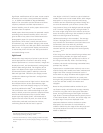
Significant modifications of this most recent coupler
a
llowed its use in the critical professional markets,
i.e., in SUPRA and SUPRA VC Digital ENDURA
Papers. The successful commercialization of these
couplers produced a twofold improvement in
thermal stability over all earlier papers that use the
p
revious class of couplers.
Kodak papers that incorporate this patented coupler
technology have thermal stability that is twice as
good as that of any other silver halide-based color
photographic paper. For portrait and social
applications, which have a totally thermal-driven
environment (e.g., dark album storage), this means
that prints will last over 200 years before noticeable
fade occurs. In a typical home display environment,
it means that prints will last over 100 years before
noticeable fading occurs.
Light Levels
Because the large majority of prints in portrait and
social applications are stored in the dark, strong
thermal performance is a must. However, images are
displayed as well, and simultaneously undergo both
thermal fade and light fade. The longevity of the
paper will depend on the light levels that will be
encountered and the paper‘s stability to thermal
fade and light fade. Therefore, the design process
includes the balancing of thermal- and light-fade
mechanisms.
A study to measure actual light levels in homes has
documented 120 lux as the representative light
intensity for the home display category. This study
was first published in 1987
12
and repeated in 1991.
13
The conclusions were confirmed through a 10-year
study in which prints w
ere placed in people’s homes
around the United States, kept in places where
people typically display prints, and measured at
regular intervals. After 10 years, the level of fade
v
erified the pr
edict
ed le
vel based on 120 lux,
confirming that the 120 lux level is typical.
How bright is 120 lux? Consider a typical suburban
m
iddle-class home in the United States, with images
displayed in a living room with two west-facing
windows and one south-facing window. Taking into
account the seasonal cycle of short (winter) and
long (summer) days, with daylight periods averaged
o
ver a 12-hour “daylight period,” the light levels in
the room might range from 50 to 100 lux at the low
t
imes of the day (morning in this example) to 150 to
200 lux at the high times of the day
(afternoon/evening in this example). The average
12-hour “daylight period” would include times of
only indirect sun illumination, times with direct sun
illumination, and times with only artificial
illumination. Over the course of these daily and
seasonal periods, the average level would typically
be 120 lux.
14,15
If the living room had two south-facing windows and
one west-facing window, the light levels would
average somewhat higher, perhaps up to 150 lux. If
the living room had only north- and east-facing
windows, the levels would average somewhat lower,
perhaps only 100 lux.
Apartments or condominiums with only one or two
outside-facing walls would have fewer windows and
might have lower average illumination levels. A
house with very large windows and skylights could
have intensity levels of 1000 lux at a peak point
during the day, depending on the room orientation
to the sun and the number of windows and
skylights.
Based on the published studies and the 10-
y
ear
verification study, we believe the average intensity
of 120 lux is a good one for the typical suburban
home, and a good a
v
er
ag
e of the higher and lower
light levels in homes and apartments typically found
in the United States. Of course, the actual range can
be quite large. From prints displayed in the
apartment bedroom with no windows to prints
displayed in the sunroom of a lavish home in
southern Calif
ornia, the range of the daily high and
lo
w points widens fr
om near zero to as high as
4000 or 5000 lux.
12
S. Anderson and G. Larson, “A Study of Environmental Conditions
Associated with C
ust
omer Keeping of Photographic Prints,”
Journal of Imaging T
echnology
,
13, 198
7
, pp. 49–54.
13
S. Anderson and R. Anderson, “A Study of Lighting Conditions Associated
with Print Displa
y in Homes,
”
Journal of Imaging T
echnology
,
17 (3), 1991, pp
.
127–131.
14
Op
. cit., S. Ander
son and G. Lar
son.
15
Op
. cit., S. Anderson and R. Anderson.
8
















